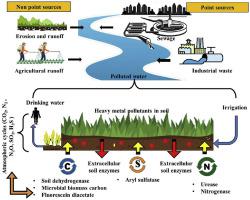Journal of Environmental Management ( IF 8.7 ) Pub Date : 2020-07-04 , DOI: 10.1016/j.jenvman.2020.110517 Pooja Singh 1 , Tapan Jyoti Purakayastha 2 , Sudip Mitra 3 , Arpan Bhowmik 4 , Daniel C W Tsang 5

|
The Yamuna is one of the most polluted rivers in India and the land adjacent to river flowing through Delhi city is widely irrigated with its water for growing various food crops. Present study was undertaken to assess the heavy metal load in Yamuna water and surrounding soils of the river bank and its impact on soil enzyme activities. Long term impact of irrigation by Yamuna water on the activities of various soil enzymes namely dehydrogenase (DHA), urease (UA), fluroscein diacetate (FDA), aryl sulphatase (ASA), nitrate reductase (NRA), microbial biomass carbon (MBC) and potentially mineralizable nitrogen (PMN) were assessed. The sensitivity of soil enzymes to heavy metals were observed as DHA>UA>ASA>NRS. Total organic carbon, easily oxidisable soil organic carbon, available phosphorus and available potassium in different sites varied significantly. Total heavy metal contents in soils showed a decreasing order: Fe>Mn>Zn>Cr>Ni>Cu>Pb>Co>As>Cd and the DTPA extractable heavy metal contents followed the order: Mn>Cu>Pb>Zn >Fe>Ni>Cd>Cr>Co>As. Potential ecological risk factors (Er) were under low risk and comprehensive potential ecological risk indices (Ri) were found to be under low, moderate and high risk categories. Copper (Cu) is the main pollutant contributing considerable load to Ri. From (Ri) principal component analysis and cluster analysis, it is evident that the Okhla site (S8) is most contaminated. The water from Yamuna river needs to be cautiously used for growing various food crops on land adjacent to the river as its long-term usage might cross the permissible limits of heavy metals in the soil.
中文翻译:

重金属负载的河水灌溉影响土壤生物活性和危险因素。
亚穆纳河是印度污染最严重的河流之一,与流经德里市的河流相邻的土地被广泛灌溉,以灌溉各种粮食作物。目前的研究旨在评估亚穆纳河水和河岸周围土壤中的重金属负荷及其对土壤酶活性的影响。Yamuna水灌溉对各种土壤酶活性的长期影响,这些酶包括脱氢酶(DHA),脲酶(UA),氟乙酸双乙酸酯(FDA),芳基硫酸酯酶(ASA),硝酸还原酶(NRA),微生物生物量碳(MBC)并评估了潜在的可矿化氮(PMN)。土壤酶对重金属的敏感性为DHA> UA> ASA> NRS。总有机碳,易氧化的土壤有机碳 不同部位的有效磷和有效钾差异很大。土壤中的总重金属含量呈降序:Fe> Mn> Zn> Cr> Ni> Cu> Pb> Co> As> Cd,DTPA可提取的重金属含量依次为:Mn> Cu> Pb> Zn> Fe > Ni> Cd> Cr> Co> As。潜在的生态风险因素(Er)处于低风险之下,综合潜在生态风险指数(Ri)被分为低,中和高风险类别。铜(Cu)是主要污染物,对Ri造成了相当大的负担。从(Ri)主成分分析和聚类分析可以看出,Okhla站点(S8)受污染最大。Yamuna河的水需要谨慎使用,以在该河附近的土地上种植各种粮食作物,因为长期使用可能会超过土壤中重金属的允许限量。



























 京公网安备 11010802027423号
京公网安备 11010802027423号